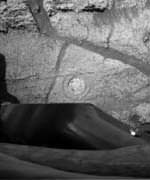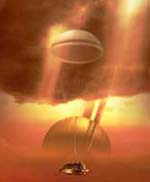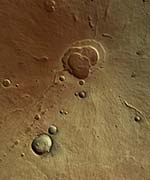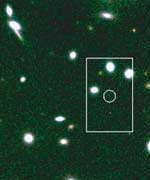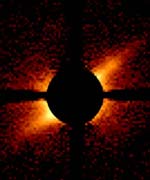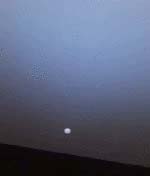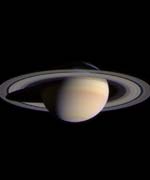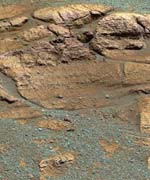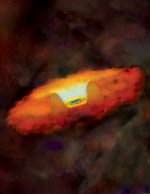
Image credit: NASA
Stephen Hawking and Kip Thorne may owe John Preskill a set of encyclopedias.
In 1997, the three cosmologists made a famous bet as to whether information that enters a black hole ceases to exist — that is, whether the interior of a black hole is changed at all by the characteristics of particles that enter it.
Hawking?s research suggested that the particles have no effect whatsoever. But his theory violated the laws of quantum mechanics and created a contradiction known as the ?information paradox.?
Now physicists at Ohio State University have proposed a solution using string theory, a theory which holds that all particles in the universe are made of tiny vibrating strings.
Samir Mathur and his colleagues have derived an extensive set of equations that strongly suggest that the information continues to exist — bound up in a giant tangle of strings that fills a black hole from its core to its surface.
The finding suggests that black holes are not smooth, featureless entities as scientists have long thought.
Instead, they are stringy ?fuzzballs.?
Mathur, professor of physics at Ohio State, suspects that Hawking and Thorne won?t be particularly surprised by the outcome of the study, which appears in the March 1 issue of the journal Nuclear Physics B.
In their wager, Hawking, professor of mathematics at the University of Cambridge, and Thorne, professor of theoretical physics at Caltech, bet that information that enters a black hole is destroyed, while Preskill — also a professor of theoretical physics at Caltech — took the opposite view. The stakes were a set of encyclopedias.
?I think that most people gave up on the idea that information was destroyed once the idea of string theory rose to prominence in 1995,? Mathur said. ?It?s just that nobody has been able to prove that the information survives before now.?
In the classical model of how black holes form, a supermassive object, such as a giant star, collapses to form a very small point of infinite gravity, called a singularity. A special region in space surrounds the singularity, and any object that crosses the region?s border, known as the event horizon, is pulled into the black hole, never to return.
In theory, not even light can escape from a black hole.
The diameter of the event horizon depends on the mass of the object that formed it. For instance, if the sun collapsed into a singularity, its event horizon would measure approximately 3 kilometers (1.9 miles) across. If Earth followed suit, its event horizon would only measure 1 centimeter (0.4 inches).
As to what lies in the region between a singularity and its event horizon, physicists have always drawn a blank, literally. No matter what type of material formed the singularity, the area inside the event horizon was supposed to be devoid of any structure or measurable characteristics.
And therein lies the problem.
?The problem with the classical theory is that you could use any combination of particles to make the black hole — protons, electrons, stars, planets, whatever — and it would make no difference. There must be billions of ways to make a black hole, yet with the classical model the final state of the system is always the same,? Mathur said.
That kind of uniformity violates the quantum mechanical law of reversibility, he explained. Physicists must be able to trace the end product of any process, including the process that makes a black hole, back to the conditions that created it.
If all black holes are the same, then no black hole can be traced back to its unique beginning, and any information about the particles that created it is lost forever at the moment the hole forms.
?Nobody really believes that now, but nobody could ever find anything wrong with the classical argument, either,? Mathur said. ?We can now propose what went wrong.?
In 2000, string theorists named the information paradox number eight on their top-ten list of physics problems to be solved during the next millennium. That list included questions such as ?what is the lifetime of a proton?? and ?how can quantum gravity help explain the origin of the universe??
Mathur began working on the information paradox when he was an assistant professor at the Massachusetts Institute of Technology, and he attacked the problem full time after joining the Ohio State faculty in 2000.
With postdoctoral researcher Oleg Lunin, Mathur computed the structure of objects that lie in-between simple string states and large classical black holes. Instead of being tiny objects, they turned out to be large. Recently, he and two doctoral students — Ashish Saxena and Yogesh Srivastava — found that the same picture of a ?fuzzball? continued to hold true for objects more closely resembling a classic black hole. Those new results appear in Nuclear Physics B.
According to string theory, all the fundamental particles of the universe — protons, neutrons, and electrons — are made of different combinations of strings. But as tiny as strings are, Mathur believes they can form large black holes through a phenomenon called fractional tension.
Strings are stretchable, he said, but each carries a certain amount of tension, as does a guitar string. With fractional tension, the tension decreases as the string gets longer.
Just as a long guitar string is easier to pluck than a short guitar string, a long strand of quantum mechanical strings joined together is easier to stretch than a single string, Mathur said.
So when a great many strings join together, as they would in order to form the many particles necessary for a very massive object like a black hole, the combined ball of string is very stretchy, and expands to a wide diameter.
When the Ohio State physicists derived their formula for the diameter of a fuzzy black hole made of strings, they found that it matched the diameter of the black hole event horizon suggested by the classical model.
Since Mathur?s conjecture suggests that strings continue to exist inside the black hole, and the nature of the strings depends on the particles that made up the original source material, then each black hole is as unique as are the stars, planets, or galaxy that formed it. The strings from any subsequent material that enters the black hole would remain traceable as well.
That means a black hole can be traced back to its original conditions, and information survives.
This research was supported in part by the U.S. Department of Energy.
Original Source: Ohio State University News Release

